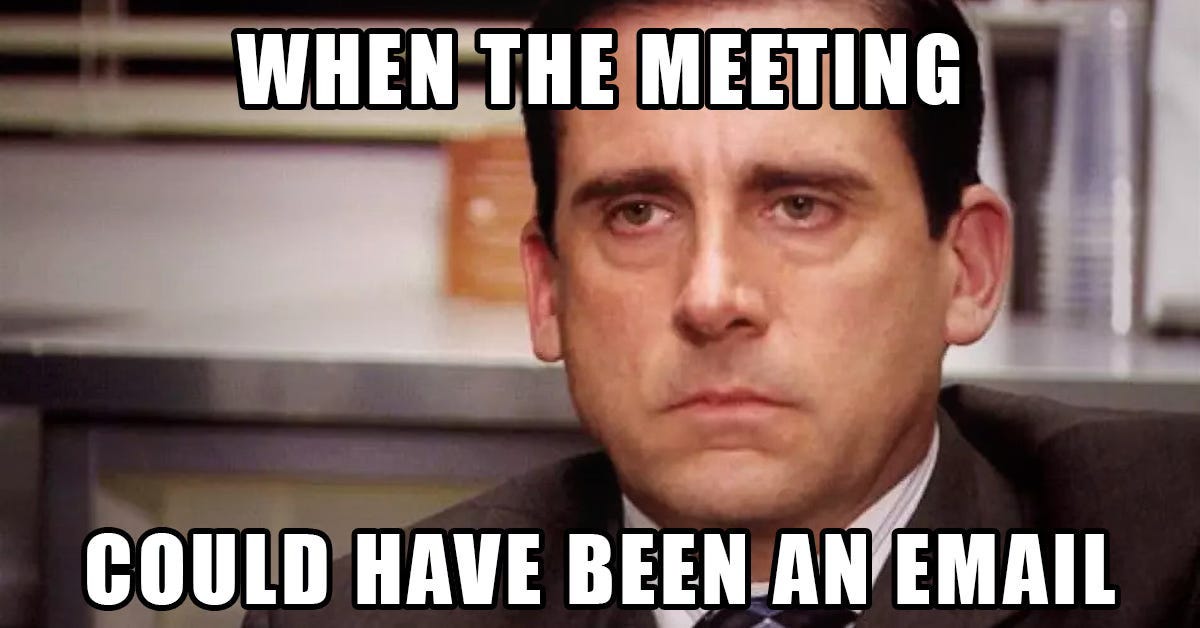Stop broadcasting, start meeting
Participation. By any means necessary.
Passive meetings are a problem.
Imagine you had to pay $100 per attendee for every meeting you arrange. Or that there was an admission fee of $50 for every meeting you attended. Would you still be in those meetings?
Meetings cost your organisation real money; the people in your meeting could be creating value elsewhere.
In some cases, a meeting should be valuable because of the people in the room. For example, it may be the only time in the week that a group of leaders spends together.
As often as not, a meeting destroys value because it’s an interruption to people’s days, causing context switching. Research from Microsoft has found that 68% of people complain of not having enough focus time in their day.
If meetings cost money, are you getting a return on that investment? When over one-third of people say that they would not be missed in the majority of their meetings, probably not.
Too many meetings are filled with passive attendees who never speak. If your meetings have few meaningful interactions, or feel like a series of speeches or presentations interspersed with silence, whatever you’re achieving, it’s not value creation. It’s certainly not enthusiasm for your mission.
Could this meeting be an email?
If a meeting could be an email, you should make it an email. In fact, you should also make it a Slack message, share it on Notion - send it through many channels to give people the best chance to absorb it.
I’m not suggesting all update-style meetings are bad. There’s a lot to be said for a synchronous update where you need to gauge reactions or gather feedback. Even though getting that response is critical, in the moment, it’s easy to move on without taking the time to gather opinions, wasting this valuable opportunity.
I’ve written before about putting ideas to a vote where feedback doesn’t flow naturally. You might need to go deeper on a particular subject, or it may be that after people get used to a period of democracy and votes, apathy sets in. How do we create fresh energy and debate?
The five-minute feedback fix
What’s worked for me here has been to get people to spend five minutes silently recording their thoughts. The silence is important because it stops the loudest voice taking centre stage. By letting each person record their thoughts separately, you can find common themes or uncover fresh perspectives for debate.
If everyone is in person, you can give them sticky notes and put them on the wall when the time expires. If any participants are online, everyone can record in an online collaboration tool such as Miro or Lucidchart with Private mode on.
When the time expires, you can review the notes and ask for context. Remember to be respectful and thank people who raise issues. Ask clarifying questions to encourage debate, and open up fresh perspectives. Group themes so you can understand the spread of opinions in the room, and the number of people who have similar perspectives.
The result is a visual artefact of the room’s thinking—clusters of insight and alignment, highlighted areas of concern and disagreement. This artefact will enable you to take account of all of this data as you figure out next steps for your proposition.
Maximising Meeting Effectiveness
If a meeting can be an asynchronous update, send lots of asynchronous updates.
If you want to engage people in problem solving beyond the superficial, get them to silently write their thoughts for five minutes.
Gather themes and validate understanding.
Acknowledge the feedback and use these to inform next steps.
Action for your next meeting
Silence may make your meetings go faster, but it’s rarely making your business more effective. At your next meeting, look at the number of people in the room. Ask yourself “What’s this meeting’s ROI?”
If you’re not getting feedback, you’re not getting value.




